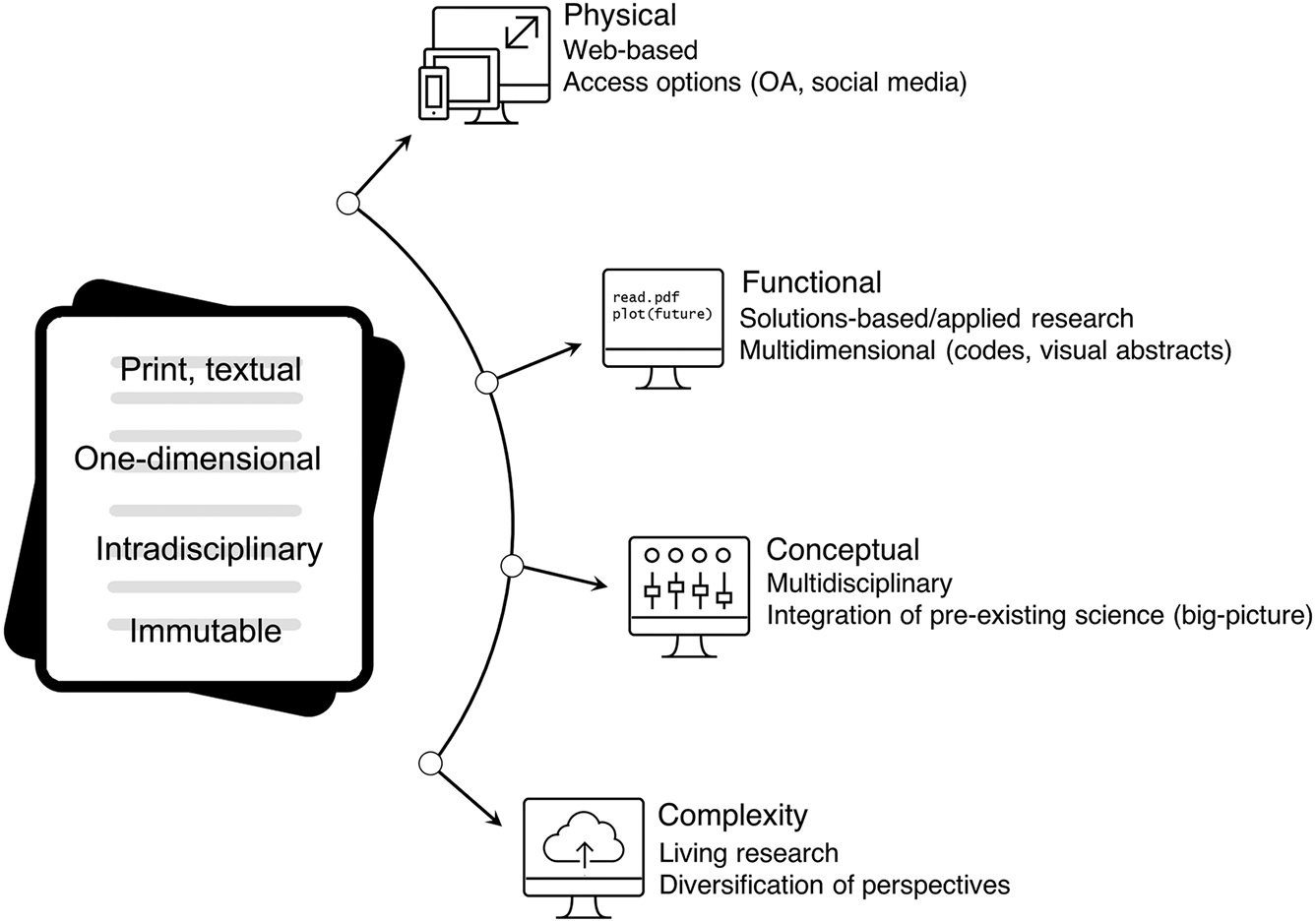Abstract
Consider for a moment the rate of advancement in the scientific understanding of DNA. It is formidable; from Fredrich Miescher’s nuclein extraction in the 1860s to Rosalind Franklin’s double helix X-ray in the 1950s to revolutionary next-generation sequencing in the late 2000s. Now consider the scientific paper, the medium used to describe and publish these advances. How is the scientific paper advancing to meet the needs of those who generate and use scientific information? We review four essential qualities for the scientific paper of the future: (i) a robust source of trustworthy information that remains peer reviewed and is (ii) communicated to diverse users in diverse ways, (iii) open access, and (iv) has a measurable impact beyond Impact Factor. Since its inception, scientific literature has proliferated. We discuss the continuation and expansion of practices already in place including: freely accessible data and analytical code, living research and reviews, changes to peer review to improve representation of under-represented groups, plain language summaries, preprint servers, evidence-informed decision-making, and altmetrics.
1. Introduction
In the mid-17th century, the Royal Society of London began sharing letters that reported discoveries in their publication Philosophical Transactions (Harmon and Gross 2007). These published observations, read and scrutinized by the natural philosophers of the time, were among the first formalized disseminations of scientific information in article format. Over three and a half centuries later, subject experts review articles through the peer-review process and before publication in scientific journals. Collectively, articles are the primary source of vetted and reputable scientific information (Bornmann 2011). Although the peer-review process (Weber et al. 2002; Smith 2006; Resnik 2011) and publication enterprise (Lortie 2011) are not without criticism, such articles remain the bread and butter of contemporary knowledge sharing within the scholarly community (Kassirer and Campion 1994). The substance of journal articles (hereinafter, paper(s)) drives the scientific endeavour (Robertson 2009; Bornmann 2011).
Not that long ago, printed and bound journals lined seemingly endless shelves and rows in library “stacks”—the repository for scientific papers. With the advent of the digital era, physical and functional aspects of scholarly publishing and science communication have begun to shift (see Fig. 1). Publishers and authors are embracing digitally based practices including social media (Darling et al. 2013) and multimedia abstracts (Spicer 2014). Despite efforts to advance digitization (for a discussion, see Owen 2007; Aalbersberg et al. 2014), today’s scientific paper remains rooted in print traditions; a multi-page document with text and static images that is now considered by some to be “obsolete” (Somers 2018). As the number of researchers and journals is steadily increasing (Ware and Mabe 2005; Jinha 2010), the number of papers is doubling approximately every nine years (Bornmann and Mutz 2015). This tremendous growth in publication rate has led to information overload for both producers and users of scientific knowledge (Piñero 2018). How can today’s scientific papers remain the bedrock of evidence for society in an ever-evolving science and science publishing environment?

Fig. 1. Expanding facets (physical, functional, conceptual, complexity) of the scientific paper. OA, open access.
We summarize perspectives, discussions, and graphical outputs (Figs. S1–S3) from the 2017 Canadian Science Policy Conference panel on “Designing the scientific paper of the future”. We do not propose earth-shattering or revolutionary ideas around how scientific papers are likely to evolve. Instead, we pinpoint current trends and innovative approaches to crafting and disseminating scientific papers—tools that increase the rate and ways in which science can progress. The novelty of the paper of the future (compared with today’s paper) will arise from a combination of approaches that increase the impact and reach of research. Herein, we discuss four qualities—that address the physical, functional, conceptual, and complexity requirements—the scientific paper of the future should embody (Fig. 1). Our discussion is not meant to be exhaustive. The qualities of the scientific paper of the future currently exist, but adoption is not universal. For each quality, we offer some of the most promising recommendations for publishing authors to consider; we also offer recommendations for publishers and institutions to further inform authors who may be part of editorial boards or have administrative roles at their institutions (Table 1). However, definitive solutions to issues raised are beyond the scope of this paper. Numerous other ideas are worthy of discussion; because of space limitations we do not include all ideas in this paper (but see Figs. S1–S3). For example, we find merit in the potential for blockchain technology and “decentralized” scholarly publishing (van Rossum 2017), poetic abstracts (Illingworth 2016), revised authorship practices (e.g., CRediT; https://www.casrai.org/credit.html), and the use of artificial intelligence to tailor literature searches (e.g., Meta, www.meta.org). The reader may want to delve into these topics.


